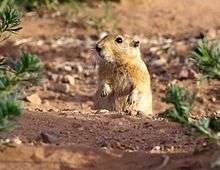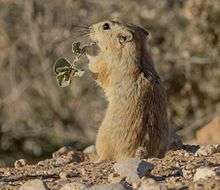Fat sand rat
| Fat sand rat | |
|---|---|
 | |
| Scientific classification | |
| Kingdom: | Animalia |
| Phylum: | Chordata |
| Class: | Mammalia |
| Order: | Rodentia |
| Family: | Muridae |
| Genus: | Psammomys |
| Species: | P. obesus |
| Binomial name | |
| Psammomys obesus Cretzschmar, 1828 | |
The fat sand rat (Psammomys obesus) is a terrestrial mammal from the gerbil subfamily that is mostly found in North Africa and the Middle East, ranging from Mauritania to the Arabian Peninsula.
Ecology
This species usually lives in sandy deserts, but may also be found in rocky terrain or saline marsh areas. It lives in burrows, which are often located under the bushes in which the rats forage, such as salt bushes of the family Chenopodiaceae. The fat sand rat is diurnal, but its activity on the surface depends on the ambient temperature. The fat sand rat normally has two litters every year; each litter usually comprises three to seven pups.

Medical significance
Although they remain lean when fed their natural, vegetable-based diet, fat sand rats can easily become obese and acquire type 2 diabetes mellitus when they are fed a normal rodent diet of grains.[2][3][4] Therefore, they have been used as an animal model for studies on diabetes and obesity. Sequencing of the complete nuclear DNA genome of Psammomys obesus showed that the Pdx1 homeobox gene, a transcriptional activator of insulin, has undergone massive nucleotide change, likely contributing to diabetes and adaptation to low caloric intake.[5]
Because they are diurnal, fat sand rats are also used as models for human seasonal affective disorder.[6]
The presence of fat sand rats in North Africa and the Middle East is of healthcare importance, as this species can harbor the parasite which causes leishmaniasis in humans.
These animals have been studied extensively for their remarkably efficient kidneys: they can produce very concentrated urine which enables them to eat halophyte plants and survive extreme heat and lack of water in their desert habitat.[7]
References
| Wikispecies has information related to Psammomys obesus |
| Wikimedia Commons has media related to Psammomys obesus. |
- ↑ S. Aulagnier & L. Granjon (2008). "Psammomys obesus". IUCN Red List of Threatened Species. Version 2011.2. International Union for Conservation of Nature. Retrieved May 20, 2012.
- ↑ Hackel, D. B.; Frohman, L; Mikat, E; Lebovitz, H. E.; Schmidt-Nielsen, K; Kinney, T. D. (1966). "Effect of diet on the glucose tolerance and plasma insulin levels of the fat sand rat (Psammomys obesus)". Diabetes. 15 (2): 105–14. doi:10.2337/diab.15.2.105. PMID 5907154.
- ↑ Kaiser, N; Cerasi, E; Leibowitz, G (2012). "Diet-Induced Diabetes in the Fat sand Rat (Psammomys obesus)". Animal Models in Diabetes Research. 933. pp. 89–102. doi:10.1007/978-1-62703-068-7_7. ISBN 978-1-62703-067-0. PMID 22893403.
- ↑ Kalderon, B; Gutman, A; Levy, E; Shafrir, E; Adler, J. H. (1986). "Characterization of stages in development of obesity-diabetes syndrome in fat sand rat (Psammomys obesus)". Diabetes. 35 (6): 717–24. doi:10.2337/diabetes.35.6.717. PMID 3519325.
- ↑ Hargreaves, Adam D.; Zhou, Long; Christensen, Josef; Marlétaz, Ferdinand; Liu, Shiping; Li, Fang; Jansen, Peter Gildsig; Spiga, Enrico; Hansen, Matilde Thye; Pedersen, Signe Vendelbo Horn; Biswas, Shameek; Serikawa, Kyle; Fox, Brian A.; Taylor, William R.; Mulley, John Frederick; Zhang, Guojie; Heller, R. Scott; Holland, Peter W. H. (2017-07-18). "Genome sequence of a diabetes-prone rodent reveals a mutation hotspot around the ParaHox gene cluster". Proceedings of the National Academy of Sciences. 114 (29): 7677–7682. doi:10.1073/pnas.1702930114. ISSN 0027-8424. PMC 5530673. PMID 28674003.
- ↑ Tal Ashkenazy; Haim Einat & Noga Kronfeld-Schor (2009). "We are in the dark here: induction of depression- and anxiety-like behaviours in the diurnal fat sand rat, by short daylight or melatonin injections". The International Journal of Neuropsychopharmacology. 12 (1): 83–93. doi:10.1017/S1461145708009115. PMID 18631427.
- ↑ Mares, Michael A. (1 November 2003). "Desert dreams: seeking the secret mammals of the salt pans - Naturalist at Large" (PDF). Natural History: 29–34.
